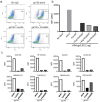This is a preprint.
Human CD4-Binding Site Antibody Elicited by Polyvalent DNA Prime-Protein Boost Vaccine Neutralizes Cross-Clade Tier-2-HIV Strains
- PMID: 37886518
- PMCID: PMC10602183
- DOI: 10.21203/rs.3.rs-3360161/v1
Human CD4-Binding Site Antibody Elicited by Polyvalent DNA Prime-Protein Boost Vaccine Neutralizes Cross-Clade Tier-2-HIV Strains
Update in
-
Human CD4-binding site antibody elicited by polyvalent DNA prime-protein boost vaccine neutralizes cross-clade tier-2-HIV strains.Nat Commun. 2024 May 21;15(1):4301. doi: 10.1038/s41467-024-48514-8. Nat Commun. 2024. PMID: 38773089 Free PMC article.
Abstract
The vaccine elicitation of HIV-neutralizing antibodies with tier-2-neutralization breadth has been a challenge. Here, we report the isolation and characteristics of a CD4-binding site specific monoclonal antibody, HmAb64, from a human volunteer immunized with a polyvalent gp120 DNA prime-protein boost vaccine. HmAb64 derived from heavy chain variable germline gene IGHV1-18, light chain germline gene IGKV1-39, and had a 3rd heavy chain complementarity determining region (CDR H3) of 15 amino acids. On a cross-clade panel of 208 HIV-1 pseudo-virus strains, HmAb64 neutralized 21 (10%), including tier-2 neutralization resistant strains from clades B, BC, C, and G. The cryo-EM structure of the antigen-binding fragment of HmAb64 bound to a conformation between prefusion closed and occluded open forms of envelope trimer, using both heavy and light CDR3s to recognize the CD4-binding loop, a critical component of the CD4-binding site. A gp120 subunit-based vaccine can thus elicit an antibody capable of tier 2-HIV neutralization.
Keywords: CD4-binding site; DNA immunization; HIV-1; Tier-2 neutralization; envelope glycoprotein; gp120; monoclonal antibody; vaccine.
Conflict of interest statement
Conflict of interest: Patents related to PDPHV were licensed by the University of Massachusetts Medical School to Worcester HIV Vaccine (WHV), a private biotech company dedicated to HIV vaccine product development.
Figures







References
-
- Chou R., et al. Preexposure Prophylaxis for the Prevention of HIV Infection: Evidence Report and Systematic Review for the US Preventive Services Task Force. JAMA 321, 2214–2230 (2019). - PubMed
-
- UNAIDS. UNAIDS Fact Sheet 2022. https://www.unaids.org/sites/default/files/media_asset/UNAIDS_FactSheet_... (accessed September 21 2022). (2021).
-
- Stamatatos L., Morris L., Burton D.R. & Mascola J.R. Neutralizing antibodies generated during natural HIV-1 infection: good news for an HIV-1 vaccine? Nat Med 15, 866–870 (2009). - PubMed
Publication types
Grants and funding
LinkOut - more resources
Full Text Sources
Research Materials
Miscellaneous

